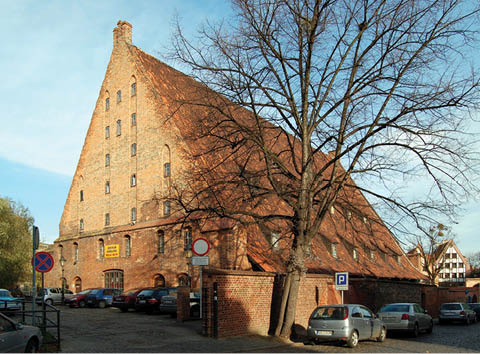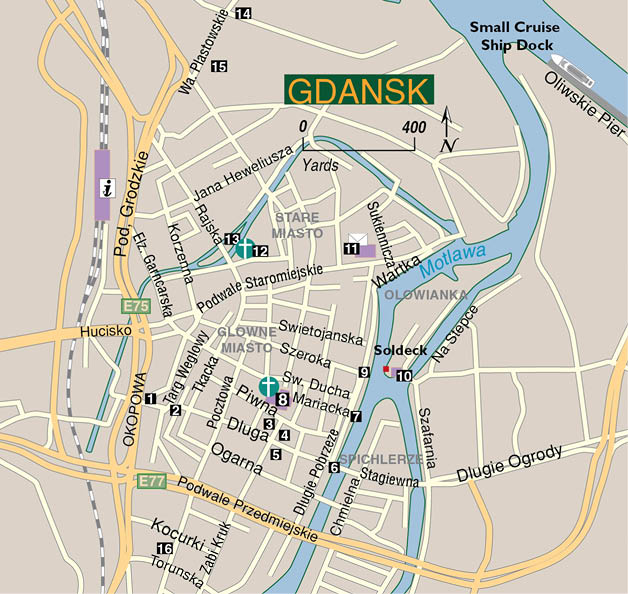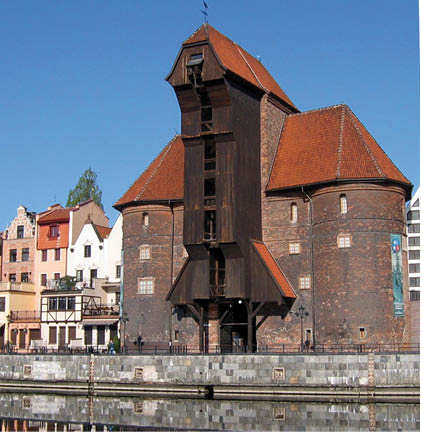Getting Around Gdansk

Gdansk lies at the mouth of the Motlawa River and is the major cruise port of the Trojmiasto (Three City) metropolitan area, which includes Sopot (a beach resort) and the port of Gdynia, located about 10 miles (16 km) northwest of Gdansk.
There are two cruise quays servicing Gdansk, both of which are located in the outer harbour about 3.5 miles (6 km) from the city centre. Smaller ships (under 40,000 tons) usually dock at Oliwskie Quay, from which you can travel to the city centre by tram, train, taxi or ship’s shuttle (if provided). The tram stop is a short walk from the cruise dock and the train station is about half a mile (1 km) away. Taxis are also available. The other Gdansk cruise quay – Westerplatte Ferry Terminal – has fewer facilities but taxis are available.
The main cruise port where almost all large ships dock is at Gydnia and is a 45-minute drive to Gdansk’s historic centre. The one-way taxi fare is about $40. Train service is also available.
Gdansk’s attractions are concentrated in Glowne Miasto (Main Town) – the city’s historic quarter of pedestrian cobblestone streets. Malbork, home to a 14th-century castle, is a two-hour drive from Gdansk and can be reached by train or on a ship-organized excursion.

Shops are housed in the Great Mill.
Gdansk is best known for its amber jewellery, sold in local shops such as those concentrated on Mariacka Street. A collection of shops and boutiques is housed in the Great Mill – a 14th-century brick building located on a small island in the canal running past St. Catherine’s Church.
Good lunch spots in Gdansk can be found among the many cafés near St. Mary’s Church, including Cafe Kamienica on Mariacka Street and, for the city’s best pierogies, Pierogarnia u Dzika on Piwna.

Old Town Hall houses the Gdansk History Museum.
1. High Gate – Several Renaissance gates mark the entrances into Glowne Miasto (Main Town). Visitors entering from the west along the historical Royal Road (a royal processional route) will pass through High Gate (also called Upland Gate), past the Amber Museum (which is housed in a medieval torture chamber), then through Golden Gate before proceeding along Ulica Dlugi (Long Street).
Map of Gdansk

2. Golden Gate – The gate leading to Ulica Dlugi.
3. Old Town Hall – This main pedestrian street leads to the city’s central square, which is overlooked by Ratusz Glowny (Old Town Hall).
4. Artus Mansion – This rebuilt 14th-century building houses the Gdansk History Museum and its tall spire is crowned with a gilded statue of Sigismund II, the last king of the Jagiello dynasty. Dwor Artusa (Artus Mansion), an elegant mansion named for the mythical King Arthur, was a meeting place of the Gdansk city nobles and is now a museum containing Renaissance furniture and artwork.
5. Neptune Fountain – Standing in the centre of the square is Fontanna Neptuna (Neptune Fountain), its rococo sculptures symbolizing Gdansk’s bond with the sea.

Green Gate.
6. Green Gate – One of the eastern entrances to the old town, this gate was built in the mid-1500s as the official residence of Polish monarchs, its design inspired by Antwerp City Hall and reflecting Flemish mannerism.
7. Gate of St. Mary – Mariacka Gate (Gate of St. Mary) marks the riverside entrance to Mariacka Street, one of the old town’s most beautiful streets, which features stone porches and dragonhead gutter spouts.
8. Church of St. Mary – This cobblestoned street is lined with shops selling amber jewellery and leads to the Church of St. Mary, one of the largest Brick Gothic churches ever built. Completed in 1343, the church initially held 22 altars. The climb to the top of its tower, which features a 15th-century astronomical clock, provides panoramic views.

The Harbour Crane.
9. The Harbour Crane – Built in the 14th century to unload cargo and is part of the Maritime Museum.
10. Maritime Museum – located on the far side of the river where the Soldeck, a museum ship, is permanently moored.
11. The Memorial to the Defenders of Post Office Square – A stainless steel monument, unveiled in 1979, standing opposite the post office, which was rebuilt after World War II and now contains a small museum about the Polish civilians who bravely battled the German SS.
12. St. Catherine’s Church – The oldest church in Gdansk, begun in the 1220s, its tower constructed in the 1480s.
13. The Great Mill – Situated on a small island in the nearby canal, this mill is a 14th-century brick building constructed by the Teutonic Knights and now housing shops.
14. Monument to Fallen Shipyard Workers – The famous Gdansk Shipyard is on the north side of the old town, its entrance marked by the Monument to Fallen Shipyard Workers, commemorating those killed by security forces during a 1970 strike.
15. Roads to Freedom Exhibition – The new European Solidarity Center opened in 2014 with expanded space for the Roads to Freedom Exhibition. This multi-media exhibit about the Solidarity movement was originally housed inside the shipyard in the building where the Accords were signed, then moved to the basement of the Solidarity Union’s offices on Waly Piastowskie before finding a permanent home in the new center.
16. The National Museum – This museum is housed in a former Franciscan monastery located several blocks south of the old town.